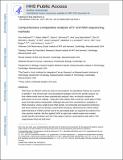Comprehensive comparative analysis of 5′-end RNA-sequencing methods
Author(s)
Regev, Aviv
DownloadAccepted version (981.7Kb)
Publisher Policy
Publisher Policy
Article is made available in accordance with the publisher's policy and may be subject to US copyright law. Please refer to the publisher's site for terms of use.
Terms of use
Metadata
Show full item recordAbstract
RNA-seq methods are required to identify the 5′ ends of transcripts, which are critical for studies of gene regulation, but these methods have not been systematically benchmarked. We directly compared six such methods, including the performance of five methods on a single human cellular RNA sample and a new spike-in RNA assay that helps circumvent challenges resulting from uncertainties in annotation and RNA processing. We found that the 'cap analysis of gene expression' (CAGE) method performed best for mRNA and that most of its unannotated peaks were supported by evidence from other genomic methods. We applied CAGE to eight brain-related samples and determined sample-specific transcription start site (TSS) usage, as well as a transcriptome-wide shift in TSS usage between fetal and adult brain.
Date issued
2018-07Department
Massachusetts Institute of Technology. Department of Biology; Koch Institute for Integrative Cancer Research at MITJournal
Nature methods
Publisher
Springer Nature
Citation
Adiconis, Xian et al. “Comprehensive comparative analysis of 5′-end RNA-sequencing methods.” Nature methods 15 (2018): 505-511 © 2018 The Author(s)
Version: Author's final manuscript
ISSN
1548-7091